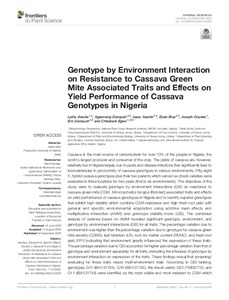| dc.contributor.author | Jiwuba, L. |
| dc.contributor.author | Danquah, A. |
| dc.contributor.author | Asante, I. |
| dc.contributor.author | Blay, E. |
| dc.contributor.author | Onyeka, J. |
| dc.contributor.author | Danquah, E. |
| dc.contributor.author | Egesi, C. |
| dc.date.accessioned | 2021-02-17T13:33:39Z |
| dc.date.available | 2021-02-17T13:33:39Z |
| dc.date.issued | 2020-09-04 |
| dc.identifier.citation | Jiwuba, L., Danquah, A., Asante, I., Blay, E., Onyeka, J., Danquah, E. & Egesi, C. (2020). Genotype by environment interaction on resistance to cassava green mite associated traits and effects on yield performance of cassava genotypes in Nigeria. Frontiers in Plant Science, 11, 1344: 1-13. |
| dc.identifier.issn | 1664-462X |
| dc.identifier.uri | https://hdl.handle.net/20.500.12478/7046 |
| dc.description.abstract | Cassava is the main source of carbohydrate for over 70% of the people in Nigeria, the world’s largest producer and consumer of the crop. The yields of cassava are, however, relatively low in Nigeria largely due to pests and disease infections that significantly lead to inconsistencies in productivity of cassava genotypes in various environments. Fifty-eight F1 hybrid cassava genotypes plus their two parents which served as check varieties were evaluated in three locations for two years (that is six environments). The objectives of the study were to evaluate genotype by environment interactions (GEI) on resistance to cassava green mite [CGM, Mononychellus tanajoa (Bondar)] associated traits and effects on yield performance of cassava genotypes in Nigeria and to identify superior genotypes that exhibit high stability which combine CGM resistance and high fresh root yield with general and specific environmental adaptation using additive main effects and multiplicative interaction (AMMI) and genotype stability index (GSI). The combined analysis of variance based on AMMI revealed significant genotype, environment, and genotype by environment interactions (GEI) for all traits. The percentage variation due to environment was higher than the percentage variation due to genotype for cassava green mite severity (CGMS), leaf retention (LR), root dry matter content (RDMC), and fresh root yield (FRY) indicating that environment greatly influenced the expression of these traits. The percentage variation due to GEI accounted for higher percentage variation than that of genotype and environment separately for all traits, indicating the influence of genotype by environment interaction on expression of the traits. These findings reveal that screening/evaluating for these traits needs multi-environment trials. According to GSI ranking, genotypes G31 (IBA131794), G19 (IBA131762), the check variety G52 (TMEB778), and G11 (IBA131748) were identified as the most stable and most resistant to CGM which also combine high FRY and other useful agronomic traits, implying that these traits in cassava can even be incorporated as preferred by farmers. These genotypes can be tested in more environments to determine their adaptability and potential recommendation for release to farmers for growing. |
| dc.description.sponsorship | Bill & Melinda Gates Foundation |
| dc.description.sponsorship | UKAid |
| dc.format.extent | 1-13 |
| dc.language.iso | en |
| dc.subject | Cassava |
| dc.subject | Genotype Environment Interaction |
| dc.subject | Pests of Plants |
| dc.subject | Plant Diseases |
| dc.subject | Genotypes |
| dc.subject | Nigeria |
| dc.title | Genotype by environment interaction on resistance to cassava green mite associated traits and effects on yield performance of cassava genotypes in Nigeria |
| dc.type | Journal Article |
| cg.contributor.crp | Roots, Tubers and Bananas |
| cg.contributor.affiliation | National Root Crops Research Institute, Nigeria |
| cg.contributor.affiliation | University of Ghana |
| cg.contributor.affiliation | Cornell University |
| cg.contributor.affiliation | International Institute of Tropical Agriculture |
| cg.coverage.region | Africa |
| cg.coverage.region | West Africa |
| cg.coverage.country | Nigeria |
| cg.coverage.hub | Headquarters and Western Africa Hub |
| cg.researchtheme | Biotech and Plant Breeding |
| cg.identifier.bibtexciteid | JIWUBA:2020 |
| cg.isijournal | ISI Journal |
| cg.authorship.types | CGIAR and developing country institute |
| cg.iitasubject | Agronomy |
| cg.iitasubject | Cassava |
| cg.iitasubject | Disease Control |
| cg.iitasubject | Food Security |
| cg.iitasubject | Genetic Improvement |
| cg.iitasubject | Pests of Plants |
| cg.iitasubject | Plant Breeding |
| cg.iitasubject | Plant Diseases |
| cg.iitasubject | Plant Genetic Resources |
| cg.iitasubject | Plant Production |
| cg.journal | Frontiers in Plant Science |
| cg.notes | Open Access Journal; Published online: 04 Sept 2020 |
| cg.accessibilitystatus | Open Access |
| cg.reviewstatus | Peer Review |
| cg.usagerightslicense | Creative Commons Attribution 4.0 (CC BY 0.0) |
| cg.targetaudience | Scientists |
| cg.identifier.doi | https://dx.doi.org/10.3389/fpls.2020.572200 |
| cg.iitaauthor.identifier | Chiedozie Egesi: 0000-0002-9063-2727 |
| cg.futureupdate.required | No |

